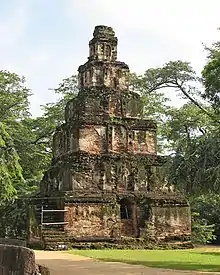
The Satmahal Prasada ("seven-story tower") is a 12th century step pyramid in the northeast corner of the archaeological complex of Polonnaruwa in Sri Lanka. It is believed to be a stupa because it is in a Buddhist environment. It is unique in the area, of unknown builder and purpose. It is often compared to the stupa at Wat Kukut in Lamphun in Thailand and to the Buddhist architecture of Cambodia.[1][2]
According to the Mahavamsa, King Parakramabahu I the Great (1123-1186) built a seven-story tower at Polonnaruwa, but there is no certainty that he refers to this one.[3]
It is made of brick and a layer of plaster. It has seven floors, although the seventh only barely remains. It has a square plan, with a lateral staircase. It presents the same decoration on its four sides. On the ground floor, there is a false entrance. On the upper floors, there is a sculpture at the centre of each wall, surrounded by an arch and holes for anchoring a niche or a similar structure.
It has been related to the pyre of Hephaestion, built in the 4th century BC by Alexander the Great in Babylon to honour that general.[4]
References
- ↑ Sirisena, W.M. (1978). Sri Lanka and South-East Asia: Political, Religious and Cultural Relations from A.D. c. 1000 to c. 1500. Leiden: E. J. Brill. p. 128. ISBN 9004056602. Retrieved 2020-04-08.
- ↑ "Sathmahal Prasada in Sri Lanka". Retrieved 2019-04-14.
- ↑ "Pannel number 51 of the archaeological site". Retrieved 2019-04-14.
- ↑ Ciordia, José M. (2020). "The Ship in the Cave: The Greek and Nautical Origin of Buddhist Architecture". Journal of Asian Architecture and Building Engineering. 19 (1): 63. doi:10.1080/13467581.2019.1697698.